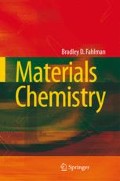Abstract
Life in the 21st century is ever dependent on an unlimited variety of advanced materials. In our consumptive world, it is easy to take for granted the macro-, micro-, and nanoscopic building blocks that comprise any item ever produced. We are spoiled by the technology that adds convenience to our lives, such as microwave ovens, laptop computers, digital cell phones, and improved modes of transportation. However, we rarely take time to think about and appreciate the materials that constitute these modern engineering feats.
Preview
Unable to display preview. Download preview PDF.
References and Notes
There is often a “grey area” concerning the best definition for small particulate matter. In particular, most structures are automatically referred to as “nanoscale materials,” fueled by the popularity of the nanotechnology revolution. However, the most precise use of the “nano” prefix (e.g., nanoparticles) is only for materials with architectural dimensions (e.g., diameters, thicknesses, etc.) of less than 100 nm; intermediate dimensions between 100 and 1,000 nm should instead be referred to as “submicron.”
CRC Handbook of Chemistry and Physics, 84th ed., CRC Press: New York, 2004.
For a thorough background on alchemy, refer to the following website: http://www.levity.com/alchemy/index.html
Balata golf ball covers may be fabricated from sap extracts of balata/bully trees in South America to produce a thin, resilient material. It is worth mentioning that balata-based materials are now produced artificially.
Most sophomore organic chemistry undergraduate textbooks provide a thorough coverage of these techniques, including the interpretation of example spectra. For more specialized books on solid-state NMR and MALDI-MS, see (respectively): Duer, M. J. Introduction to Solid-State NMR Spectroscopy, Blackwell: New York, 2005 and Pasch, H.; Schrepp, W. MALDI-TOF Mass Spectrometry of Synthetic Polymers, Springer: New York, 2003.
Further Reading
Brock, W. H. The Norton History of Chemistry, W. W. Norton: New York, 1992.
Brush, S. G. The History of Modern Science: A Guide to the Second Scientific Revolution, 1800-1950, Iowa State University Press: Ames, IA, 1988.
Oxford Companion to the History of Modern Science, Heilbron, J. L. ed., Oxford University Press: New York, 2003.
Mount, E. Milestones in Science and Technology: The Ready Reference Guide to Discoveries, Inventions, and Facts, 2nd ed., Oryx Press: Phoenix, 1994.
Rojas, P. Encyclopedia of Computers and Computer History, Fitzroy Dearborn: Chicago, 2001 (2 volumes).
Bierman, A. K.; Assali, R. N. The Critical Thinking Handbook, Prentice Hall: New Jersey, 1996.
Browne, M. N.; Keeley, S. M. Asking the Right Questions: A Guide to Critical Thinking, 5th ed., Prentice Hall: New Jersey, 1998.
Paul, R. Critical Thinking: What Every Person Needs to Survive in a Rapidly Changing World, Foundation for Critical Thinking, 1993.
Author information
Authors and Affiliations
Rights and permissions
Copyright information
© 2007 Springer
About this chapter
Cite this chapter
Fahlman, B.D. (2007). What is Materials Chemistry?. In: Materials Chemistry. Springer, Dordrecht. https://doi.org/10.1007/978-1-4020-6120-2_1
Download citation
DOI: https://doi.org/10.1007/978-1-4020-6120-2_1
Publisher Name: Springer, Dordrecht
Print ISBN: 978-1-4020-6119-6
Online ISBN: 978-1-4020-6120-2
eBook Packages: Chemistry and Materials ScienceChemistry and Material Science (R0)

